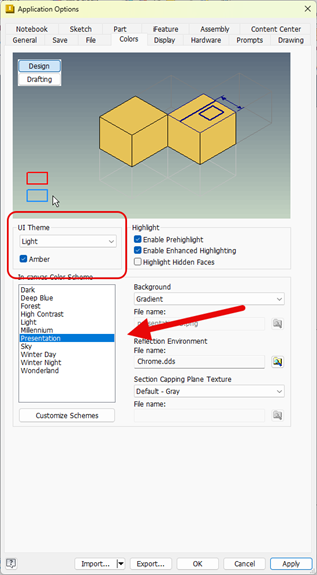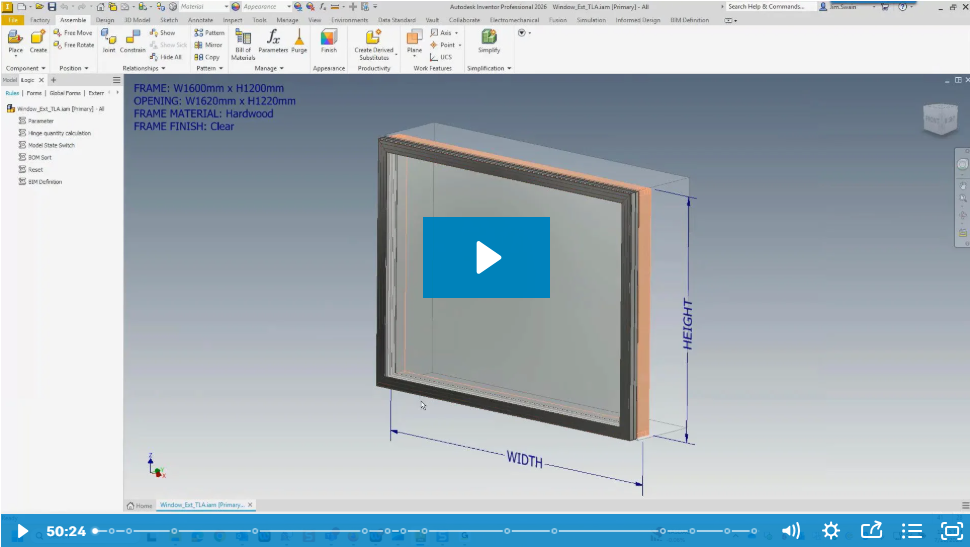Efficiency is a leading reason for manufacturing engineering departments to switch from outdated legacy systems to professional-grade 3D CAD software like Autodesk Inventor®. The goal is to accelerate mechanical design, simulation, visualization, and documentation. However, some professionals face unexpectedly prolonged processes. As it turns out, engineers accustomed to older methodologies struggle to utilize modern software capabilities fully, causing unnecessary friction.
Studies indicate that technical challenges with software products are a common cause of dissatisfaction among engineers. Teams are less likely to be productive and satisfied if they cannot fully leverage 3D CAD software, leading them to believe they are being provided with inferior systems mistakenly. The perceived lack of investment in professional development eventually leads to disengagement and higher turnover rates.
The solution is clear: investing in Autodesk Inventor® training. Teaching engineers to leverage advanced systems cuts time-consuming independent research. By equipping your team with the skills they need, you can overcome the challenges posed by new software and ensure smoother, more efficient project workflows.
In this article, we’ll discuss the importance of ongoing learning for manufacturing engineers to bridge technological gaps and help them apply advanced engineering principles with modern tools.
1. Enhancing Team Competence and Efficiency
Autodesk Inventor® is widely used by modern engineering departments for its robust parametric modeling capabilities. Skilled engineers employ sophisticated modeling techniques to deliver mechanical design and engineering tasks with greater precision. With its advanced integrated simulation tools and comprehensive functionality, Autodesk Inventor® has become an indispensable tool in modern manufacturing engineering.
However, basic modeling capabilities barely scratch the surface of what Inventor can do. Advanced Inventor training helps teams move beyond foundational functions to more sophisticated modeling techniques, allowing them to apply advanced engineering methodologies effectively.
A comprehensive instructor-led class on Inventor empowers engineers to utilize the following functionalities:
-
3D Mechanical Design: Unlike legacy systems, Autodesk Inventor®offers advanced parametric tools that support intricate 3D models and provide precise control over complex geometries and assemblies.
-
Simulation: Autodesk Inventor® includes finite element analysis (FEA) and dynamic simulation tools. These tools allow engineers to evaluate stress, strain, and motion in components and eliminate the need for time-consuming manual calculations.
-
Visualization Tools: Autodesk Inventor® moves beyond basic drafts. It produces high-fidelity visualizations, simulates real-world applications, and facilitates detailed design renderings.
Comprehensive Autodesk Inventor® training drives organizational-level improvements by enhancing team competence, fostering innovation, and optimizing project workflows.
Below is a closer look at the long-term benefits of having engineers undergo training courses like Hagerman’s Autodesk Inventor® Level 1.
-
Shorter Project Cycle Times: Proficiency in advanced modeling and assembly CAD software expedites design creation and modification, leading to faster project cycles. With proper training, even experienced engineers can maximize their efficiency and quickly master specific tools.
-
Reduced Rework: Knowing how to utilize Inventor tools enables manufacturing engineers to produce precise models that would need little rework throughout the pipeline.
-
Fewer As-Built Model Revisions: Through proper training, engineers can leverage Inventor’s diagnostic tools to foresee potential issues. This proactive approach leads to fewer revisions on as-built models and ensures equipment efficiency and reliability in final designs.
2. Driving Innovation through Advanced Capabilities
Enhancing skills through Autodesk Inventor® training not only improves current projects but also sets the stage for innovation. Mastery of CAD tools is essential for engineers to visualize and materialize ideas. Without this expertise, even the most disruptive concepts will remain theoretical.
To drive innovation, engineers can leverage a range of advanced features available in Autodesk Inventor®:
-
Parametric Modeling: Supports precise control over design parameters and constraints, enabling engineers to create detailed and rule-based models. It also eliminates the technical issues that limit configurations.
-
Freeform Modeling: Provides flexibility to create complex, organic shapes that are not easily defined by traditional geometric constraints, which gives engineers more leeway for creative and unconventional designs.
-
Direct Edit Mode: Enables quick and intuitive modifications to existing models without the need to navigate through a history tree. It streamlines the iterative design process.
For instance, Hagerman’s Advanced Part Modeling course covers essential techniques like multi-body design and surface modeling. Mastering these advanced skills ensures that engineers can express the most complex principles and achieve sophisticated, innovative designs.
3. Fostering a Culture of Continuous Learning
In dynamic industries like engineering, building a culture of continuous learning is crucial. Realizing complex designs leads to precise physical products, while ongoing learning drives innovative, industry-disrupting ideas. Training equips engineers with skills to integrate and optimize advanced design techniques.
Beyond driving innovation, fostering ongoing learning is essential for several reasons.
Job Satisfaction
While attractive compensation packages like health insurance, retirement plans, and paid vacation attract talent, fostering job satisfaction requires a focus on personal development. Providing opportunities for engineers to upskill and grow emphasizes that you value their long-term contributions and are committed to investing in their growth. Help them tackle greater challenges.
“Emphasizing professional development sends a clear message that your company cares about its employees’ futures. Moreover, it considers those employees an important part of the company’s future as well.”
- Forbes
Commitment to Professional Development
It is a misconception that employees inherently resist training. SHRM surveys show that 55 % of workers report needing more training to perform their jobs effectively, and 38% seek training relevant to their current roles.
In critical industries like engineering, continuous development is essential for maintaining high standards of knowledge and skill. It ensures that all employees, from junior engineers to C-suite executives, stay competitive and up-to-date with the latest advancements in the field.
Knowledge Sharing
Trained engineers can foster an environment of knowledge exchange and collaboration by mentoring others. Sharing skills and tips enhances team capability and cohesion, leading to more efficient project execution.
Keeping Up with Industry Standards
Autodesk Inventor® training keeps team members updated on the latest industry practices and software enhancements. Adhering to manufacturing engineering is imperative to operations. Otherwise, failing to follow these guidelines can lead to penalties, regulatory issues, and workflow inefficiencies.
Continuous learning and leveraging the latest technologies are vital for staying competitive. Hagerman’s iLogic New User Course exemplifies this commitment by teaching participants to automate routine tasks within the Autodesk Inventor® environment. By mastering iLogic automation skills, engineers can streamline tedious, repetitive workflows and free up time for more complex core responsibilities.
4. Optimizing Workflow and Project Management
Autodesk Inventor® training teaches the essential skills for streamlined project management. Features like assembly management and component reuse boost efficiency, enabling better organization and faster execution. Mastering these tools helps teams manage projects more effectively, reducing lead times and improving workflow.
Here is a closer look at how Autodesk Inventor® helps optimize engineering workflows:
Enhancing Large Dataset and Assembly Management
Autodesk Inventor® training improves data organization with project management tools. It teaches simplified model representations with Level of Detail (LOD) while ensuring precise assembly constraints and joint definitions.
Standardizing Practices Across Departments
Autodesk Inventor® standardizes workflows and toolsets through uniform templates, automated workflows (iLogic), and centralized data management. These capabilities ensure consistent design standards across teams. The immediate benefits include reduced manual errors, unified design environments, and clearer documentation.
Direct Impact on Project Delivery Timelines and Cost Efficiency
Manufacturing engineers can accelerate project completion by automating design tasks through iLogic on Autodesk Inventor®. This tool is particularly beneficial for managing routine tasks that demand swift responses. Focusing on innovative, long-term projects over immediate results optimizes efficiency and fosters sustainable growth.
Hagerman’s Advanced Assembly Modeling Course covers essential techniques to optimize workflows, such as applying motion constraints and top-down designs. These techniques are crucial for managing large projects, ensuring component compatibility, and supporting broader goals of cost reduction, efficiency, and competitive advantage.
Elevate Your Engineering Team’s Skills with Hagerman's Autodesk Inventor® Training
Investing in Autodesk Inventor® training can enhance team competence, boost productivity ratings, and even spike job satisfaction. Equipping your engineering department with professional-grade CAD tools modernizes outdated systems. Moreover, fostering a culture of ongoing learning drives innovation and ensures sustainable growth at an organizational level.
Finding the right partner for your Autodesk Inventor® training is crucial to maximizing your investment.
If you want guaranteed results, turn to the professionals at Hagerman. We’ve been an Autodesk partner since 1984. Over the years, the company has earned numerous awards, certifications, and specializations—we can impart the same level of expertise to your team. Book a consultation to learn more about our instructor-led classes!
|
|





Comments